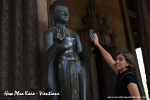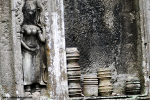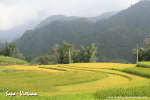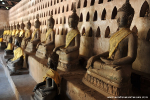1. Fukian Assembly Hall (Phuc Kien Assembly Hall)
The Fukian Assembly Hall (Phuc Kien) was established in the year 1697. It is a great example of the Chinese architecture. The Chinese merchants of the Fukian Province are believed to build this huge assembly hall. However, some changes have been made to this Fukian Assembly Hall in the course of time. As for example, the first entrance of the assembly hall was made in the year 1975. The Assembly Hall in fact is a temple that holds the sea goddess Thien Hau. Then there is goddess Thuan Phong Nhi, who is able to listen to the sound of a ship even at a distance of thousand miles. At last the goddess Thien Ly Nhan is also in the altar and she is able to see those distant ships.
Notes:
Address: 46 Tran Phu Street, Hoi An, Quang Nam Province.
Open daily, all year around
Location: In the heart of Hoi An ancient town. It normally takes 15-30 minutes to visit it.
Entrance fee: Admission by Hoi An Day-time ticket.
Highlights:
The mural on the right-hand wall – if you can see it behind the prayer coils – depicts Thien Hau, her way lit by lantern light as she crosses a stormy sea to rescue a foundering ship. On the wall opposite is a mural of the heads of the six Fujian families who fled from China to Hoi An in the 17th century.
The central altar in the last chamber contains seated figures of the heads of the six Fujian families. Behind the altar on the right are three fairies and smaller figures representing the 12 “ba mu” (midwives), each of whom teaches newborns a different skill necessary for the first year of life: smiling, sucking and so forth. Childless couples often come here to pray for offspring.
2. Ghaozhou Assembly Hall (Trieu Chau Assembly Hall)
It was built by Chinese overseas coming from Trieu Chau (China) in 1845. It is dedicated to the God of Wind and Big Waves. The house's owners hope this God will always bring luck to them and help them travel smoothly on the sea. Formerly, people often went to the house at night to pray because they thought that all their wishes would come true. The most outstanding features of the house are a sophisticated carved wooden frame, decorative designs, beautiful wooden patterns and embossed patterns made of porcelain pieces. Every year, descendants of the Trieu Chau people gather at the house from the 1st to the 16th of the first lunar month to woorship their ancestors.
Notes:
Address: 157 Nguyen Duy Hieu Street, Hoi An, Quang Nam Province.
Open daily, all year around
Location: In the heart of Hoi An ancient town. It normally takes 15-30 minutes to visit it.
Entrance fee: Admission by Hoi An Day-time ticket.
Highlights:
Highlight of this assembly hall is the greaming woodcarvings on the beams, walls and altar – absolutely stunning in their intricacy. Look for the carvings on the doors in front of the altar of two Chinese women wearing their hair in an unexpectedly Japanese style.
3. Cantonese Assembly Hall (Quang Trieu Assembly Hall)
This colorful Quang Trieu (Cantonese) Assembly Hall was established in the year 1885. Records say that the Chinese Cantonese merchants built this hall. The different parts of the building are separately made in China. After finishing the work, those parts were transferred here and joined together to build the The Quang Trieu (Cantonese) Assembly Hall in Hoi An.
Notes:
Address: 176 Tran Phu Street, Hoi An, Quang Nam Province.
Open daily, all year around
Location: In the heart of Hoi An ancient town. It normally takes 15-30 minutes to visit it.
Entrance fee: Admission by Hoi An Day-time ticket.
Highlights:
This assembly hall has a tall, airy entrance hall that opens onto a splendidly over-the-top mosaic statue of a dragon and a carp.
The very pleasant garden behind has an even more incredible dragon statue.
4. Trung Hoa Assembly Hall (Ngu Bang Assembly Hall)
Established in 1741, it was then called Duong Thuong Assembly Hall. However, many people think that it was built in the 15th century. Anyway, it is also one of the oldest assembly halls in Hoi An. It was the home of Chinese immigrants and dedicated to Thien Hau Holy Mother. The house is a place for worshipping and for gatherings. It is also a school for Chinese overseas in Hoi An.
Notes:
Address: 64 Tran Phu Street, Hoi An, Quang Nam Province.
Open daily, all year around
Location: In the heart of Hoi An ancient town. It normally takes 15-30 minutes to visit it.
Entrance fee: Admission by Hoi An Day-time ticket.
Highlights:
To the right of the entrance are portraits of Chinese resistance heroes in Vietnam who died during World War II. The well-restored red temple is dedicated to Thien Hau and sits between pavilions adorned with French-style balustrades.
{mainvote}







